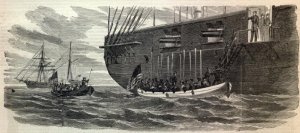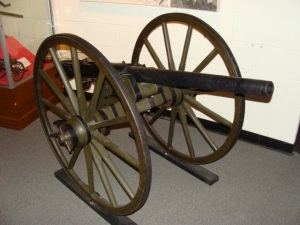I would like to share the setting I have created for my Steampunk Alternate History and how the events unfolded, leading to the present political situation.
The Crimean War (October 1853 – February 1856), in which Russia lost to an alliance of France, the United Kingdom, the Ottoman Empire, and Sardinia.
The Indian Rebellion/Mutiny (May 1857 to June 1858), the rebellion led to the dissolution of the East India Company in 1858. The country was thereafter directly governed by the crown as the new British Raj.
The Italian Unification (August 1849 to September 1870), a series of campaign’s leading to the removal of Austrian and French influence in the Italian Peninsula and the creation of a unified Kingdom of Italy.
The American Civil War (April 1861 to 1864)
Hostilities began on April 12, 1861, when Confederate forces fired upon Fort Sumter.

On November 8, 1861, the USS San Jacinto, commanded by Union Captain Charles Wilkes, intercepted the British mail packet RMS Trent and removed, as contraband of war, two Confederate diplomats, James Mason and John Slidell. The envoys were bound for Britain and France to press the
Confederacy’s case for diplomatic recognition and to lobby for possible financial and military support, in the name of cotton diplomacy. In Britain, the public disapproved at this violation of neutral rights and insult to their national honor. The British government took steps to strengthen its military forces in Canada and the Atlantic. President Abraham Lincoln and his top advisors did not want to risk war with Britain over this issue. After several tense weeks, the crisis was resolved when the Lincoln administration released the envoys and disavowed Captain Wilkes’s actions without a formal apology. Mason and Slidell resumed their voyage to Britain. After much negotiation, they arranged for an exchange of Confederate Military technology to be produced and developed under licence in Britain and France, in exchange for credit to purchase weapons and supplies to pursue the war. A deciding factor was the interest that would be paid in cotton and import/export agreements that would avoid any taxation duties between the Confederacy and British Empire. France
negotiated a similar agreement.

Part of the Military Technology shared, were the blue prints and a working example of the Williams Gun which was classified as a 1-lb cannon. It was designed by Capt. D.R. Williams, of Covington, Kentucky, who later served as an artillery captain with a battery of his design. It was a breech-loading, rapid-fire cannon that was operated by a hand-crank. The barrel was 4 feet long and 1.57-inch caliber. The hand crank opened the sliding breech which allowed the crew to load a round and cap the primer. As the crank was continued, it closed the breech and automatically released the hammer. The effective range was 800 yards but the maximum range was 2000 yards. This was quickly taken into development and trials at the Royal Arsenal, Woolwich. By 1863 the gun and been developed into a true Quick Fire weapon, by adding a overhead magazine, which carried 12 rounds. By the use of these, the rate of fire could reach over 120 rounds per minute. They were quickly put into production and a large consignment was shipped into Savannah, Georgia. From here they were issued to all of the Confederate Field Army’s.

At the Battle of Chancellorsville, April 30 1863 – May 6 1863, these new weapons were first used and rapidly decimated the Union force. The Confederate victory was marred by the loss of General ‘Stonewall’ Jackson, who died on May 10th 1863.
At the later Battle of Gettysburg, July 1 1863 – July 3 1863, the Federal death toll was immense and although the Confederate force was repulsed. It was becoming apparent that the South was gaining the upper hand.
The Battle of the Wilderness, May 5 1864 – May 7 1864, was the final breaking point. The Federal forces were destroyed in detail, as thousands surrendered, rather than march into certain death, facing the Quick Firing Cannon. JEB Stuart managed to achieve a victory over the Union Cavalry under General Sheridan at Yellow Tavern, killing General Custer in the process, as he gallantly charged head on into a deployed Confederate Battery. His body was never identified!
When the United States presidential election of 1864 was held on Tuesday, November 8, 1864. Incumbent president, Republican Abraham Lincoln, was running for re-election against Democratic candidate George B. McClellan, who ran as the “peace candidate”. It was a landslide victory for McClellan and a Ceasefire was announced on November 9th. A Peace Treaty was signed on December 18th and the Union was fragmented.
The Confederacy announced the Abolition of Slavery on December 24th, with effect from January 1st, 1865. All Slave Owners were to be paid full compensation, with money provided from the cotton sales to Europe and the Military Patents sold. On January 2nd 1865, the Confederate States of America were recognised by Britain and France, quickly followed by the rest of the European Powers.
French Intervention in Mexico ( December 8th 1861-1867)
The French invasion helped to bring to Mexico an Archduke from the Royal House of Austria, Maximilian Ferdinand, or Maximilian I. After a several years of internal warfare, with the assistance of a Confederate Expeditionary Force, which arrived in July 1865, the Mexican rebels were subdued and Peace was declared in 1867.
Austro-Prussian War (June 15–Aug. 23, 1866)
It was fought between Prussia, allied with Italy, and Austria, seconded by Bavaria, Württemberg, Saxony, Hanover, Baden, and several smaller German states. It was deliberately provoked by Bismarck, over the objections of his king, in order to expel Austria from the German Confederation as a step toward the unification of Germany under Prussian dominance. Thus the war paved the way for the establishment (1871) of the German Empire and the reorientation of Austria (reorganized in 1867 as the Austro-Hungarian Monarchy) toward the east.
California Republic (1866)
Following the Civil War, California felt no longer tied to the Union, so declared Independence on September 9 1866. This move was supported by the Confederate States and sovereignty was guaranteed in exchange for the Southern portion of the State being passed to the Confederacy. This included San Diego, which would become the Confederate port on the Pacific and Los Angeles, which became the State Capital of Southern California. Further to this, in 1871, California agreed to Japan setting up a Naval Base near Seattle, in Washington Territory, in exchange for beneficial Trade Agreements, and fueling depots located around Japanese Territory.
Alaska (1867)
Prior to the defeat of the United States, it had been hoped to sell Russian Alaska to them. But as that time had passed, it had been decided to maintain Alaska as a foot hold to possibly threaten British Canada, or as a base to operate from along the Pacific Coast.
Franco-Prussian War (July 19 – September 10, 1870)
Was a conflict between the Second French Empire and the German states of the North German Confederation led by the Kingdom of Prussia. The conflict centered on Prussian ambitions to extend German unification. Prussian chancellor Otto von Bismarck planned to provoke a French attack in order to draw the southern German states of Baden, Württemberg, Bavaria and Hesse-Darmstadt into an alliance with the Prussian dominated North German Confederation.
A Confederate Expeditionary Force arrived in France during early August, under the Command of General Longstreet, with cavalry commanded by General JEB Stuart. They joined in the Sedan Campaign, during which the Confederate Cavalry rode around the Prussian Army, severing communications and destroying supply lines. This resulted in the Prussian encirclement and surrender of the entire force and capture of Otto von Bismarck himself. On September 10th the Peace Treaty was signed. The Southern German Confederation rejoined the Austrian sphere of influence and Prussian designs on dominance were thwarted.
Russo-Turkish War (1877–78)
This was a conflict between the Ottoman Empire and the Eastern Orthodox coalition led by the Russian Empire and composed of several Balkan countries. Fought in the Balkans and in the Caucasus, it originated in emerging 19th-century Balkan nationalism. Additional factors included Russian hopes of recovering territorial losses suffered during the Crimean War, re-establishing itself in the Black Sea and supporting the political movement attempting to free Balkan nations from the Ottoman Empire.
As a result of the war, Russia succeeded in claiming several provinces in the Caucasus, namely Kars and Batumi. The principalities of Romania (which was also forced by Russia to cede the Budjak region of the Danube Delta, in spite of an existing treaty of alliance between the two countries), Serbia and Montenegro, each of which had had de facto sovereignty for some time, formally proclaimed independence from the Ottoman Empire. After almost five centuries of Ottoman domination (1396–1878), the Bulgarian state was re-established as the Principality of Bulgaria, covering the land between the Danube River and the Balkan Mountains (except Northern Dobrudja which was given to Romania) as well as the region of Sofia, which became the new state’s capital. The Congress of Berlin also allowed Austria to occupy Bosnia and Herzegovina and Great Britain to take over Cyprus.
May Your Dice Roll Well!




